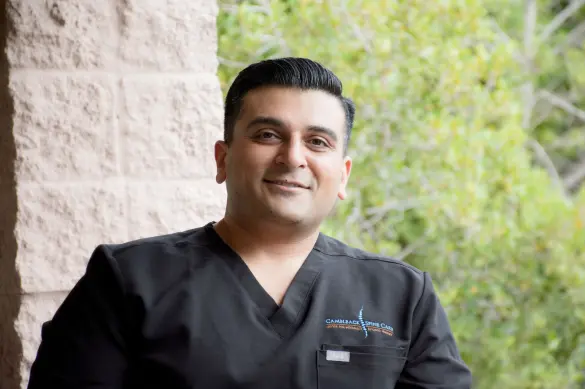

Narrowing of the spinal canal, known as spinal stenosis, is a condition that often develops as a consequence of aging and can be both painful and disabling. The surgeons at Camelback Spine Care in Sun City, Arizona, and Phoenix, Arizona, are outstanding spine surgeons in Phoenix and Sun City with extensive experience helping patients with spinal stenosis treatment. If you have back pain or are finding that your movements are becoming restricted, call our experienced spinal stenosis doctors today to schedule a consultation or book an appointment online.
Spinal stenosis is a narrowing of the spinal canal, typically caused by degenerative conditions that develop with age.
As you get older, the effects of wear and tear on your spine cause the discs that cushion your vertebrae to perform less efficiently, causing an increase in pressure. This, in turn, puts pressure on the facet joints in your spine, and the gap that your nerves occupy reduces in size.
If the facet joints are affected by osteoarthritis, the cartilage covering the ends of the bones starts to break down, causing bones to start rubbing against other bones, and leading to additional pressure and pain.
You may also develop bone spurs, which are your body’s response to the problem. The spurs are intended to support the vertebrae, but unfortunately, they add to the narrowing effect, especially as the ligaments increase in size alongside them. Our spinal stenosis doctors evaluate each case to recommend the most effective spinal stenosis treatment, whether non-surgical or surgical.
Symptoms of spinal stenosis are different areas of pain in the lower back, hips, buttocks, and one or both legs due to neurogenic claudication, which is pressure on the nerves in the lower part of the spinal cord called the cauda equina.
If you have spinal stenosis, you may also experience a sensation of heaviness in the legs or weakness, tingling, or cramping. The symptoms are usually worse when you’re walking, but improve if you sit down. Leaning forward eases the pressure on the nerves and further relieves symptoms.
There are several treatments that can help reduce the symptoms of spinal stenosis, such as:
If these therapies aren’t sufficient, surgery may be required. Our surgeons provide the best surgical option for stenosis, including decompression (laminectomy), minimally invasive spine surgery, or spinal fusion when necessary.
Decompression, or laminectomy, is the primary approach to spinal stenosis surgery. Laminectomy involves the removal of any bone, bone spurs, and ligaments that are putting pressure on the nerves in the spinal canal.
The surgeons can carry out a laminectomy using minimally invasive laparoscopic surgical techniques for most patients. They can also combine a laminectomy with spinal fusion or stabilization surgery if arthritic degeneration is causing spinal instability.
Alternatively, our surgeons may recommend a different minimally invasive procedure using interspinous process devices. This technique involves fitting specially designed spacers between the spinous processes at the back of the spine to keep the vertebrae apart and ensure there is enough room for the nerves.
If you are experiencing back pain or symptoms of spinal stenosis, call our spinal stenosis doctors at Camelback Spine Care today, or book an appointment online for personalized spinal stenosis treatment.
WHAT WE OFFER

Neck Pain
LEARN MORE
Osteoporosis
LEARN MORE
Lower Back Pain
LEARN MORE
Arthritis
LEARN MORE
Herniated Disc
LEARN MORE
Spinal Stenosis
LEARN MORE
Degenerative Disc
LEARN MORE
Scoliosis
LEARN MORE

